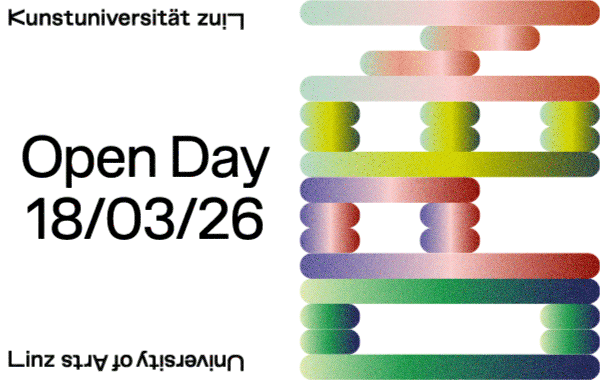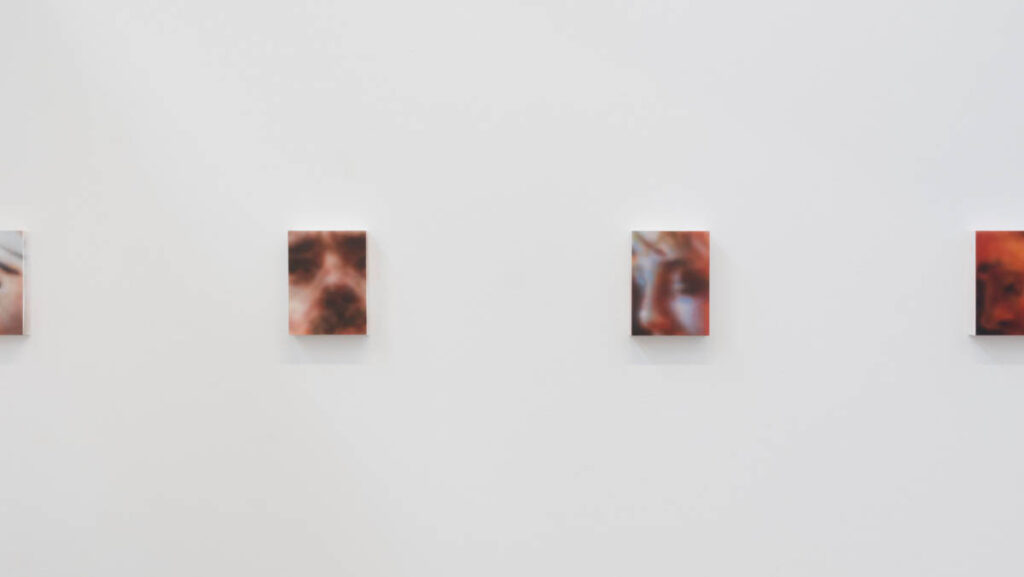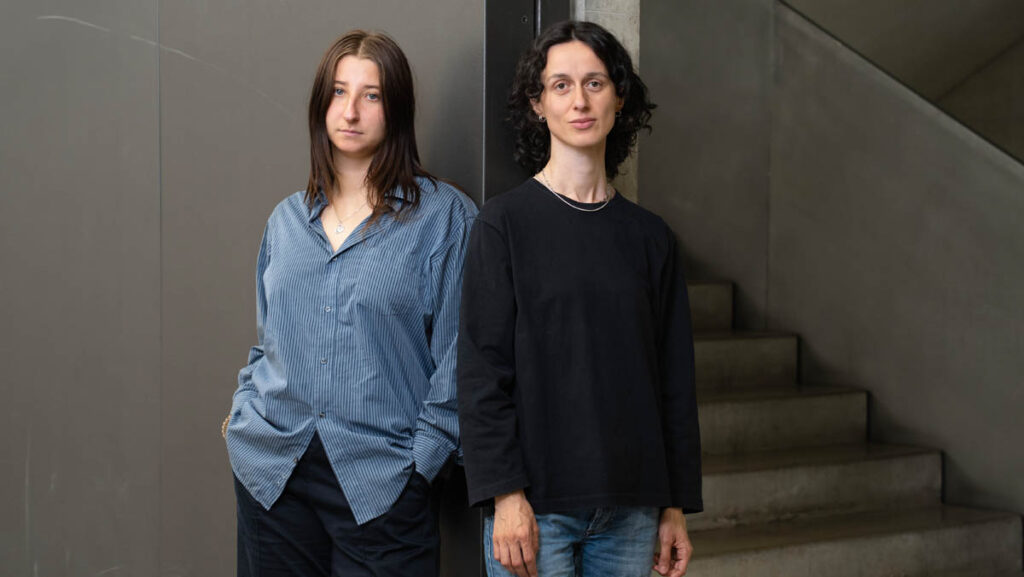
Could you tell us a little about your childhood and youth there?
I grew up in Wintersdorf (Thuringia), a village of about 3,000 people. We lived on the edge of the village, surrounded by forests. I spent a lot of time in nature, walking in the forest, observing the landscape. At the same time, the forest was often used for military exercises by the Russians, so my environment was shaped both by politics and by natural processes.
What fascinated me most were the changes in the landscape, and those observations continue to influence my work today.

I used to collect objects, plants, stones, and other small things, keeping them in jars in my children’s room to watch how they changed over time. That was my first “studio,” so to speak. I still work with processes of change today. My work doesn’t follow a strict thread; it grows out of what I notice and engage with, political issues, interpersonal encounters, nature, and animals. The choice of materials in my practice follows from the subject matter.
You moved to Berlin later. Did you study sculpture right away?
I moved there in 1994, but I didn’t start studying until much later. Right after school, I co-founded the Fusion Festival and built and welded large sculptural objects out of scrap metal for it. Later, I worked with NGOs, which I still think are far more important than governments in defending freedom. Only after that did I decide to study art and sculpture.
What was Berlin like for you at that time?
Berlin in the ’90s had no functioning infrastructure yet, and that created a lot of freedom for art making. For instance, I once transformed a Renault Clio into a giant armadillo and drove it through the streets, something that was only possible there at the time. Artist groups were everywhere, older and more experienced than me, and that atmosphere shaped me. Much was improvised, raw, and inexpensive. You get the feeling that by doing and by taking action, you can get approval, and great things have already been achieved.


You work with a wide range of materials and scales. Is planning always central to your process?
Yes, for me, planning is half the work. Many of my pieces are large, making them labor-intensive, research-intensive, and material-intensive. I think carefully about form, material, light, and presentation. I plan long-term and in steps: sketches, measurements, models, before even moving into production. Depending on the project, I work with teams: programmers, structural engineers, metalworkers, and architects.
Especially in public space, you need precision both technically and legally, because sculptures must hold, endure, and remain safe.

Your sculptures often deal with socio-political issues. Why is that important to you?
It comes from my background. For me, art cannot be separate from politics. Art is not only freedom; it is also responsibility. My work often confronts difficult issues—animal welfare, environmental protection, and human rights. I believe responsibility lies not only with governments or NGOs, but with each individual. Public art creates encounters that mainstream media often ignores, and that’s where I believe art can broaden perspectives.
How do you select locations for your work? You’ve also created interactive sculptures. What role does participation play?
The location is crucial. It amplifies the message. For example, placing the uncoiled revolver between the Federal Chancellery and the Reichstag ensures it is photographed and discussed with maximum visibility.

Interactivity transforms viewers into participants. For example, in my fountain installation, when someone throws in a coin, the waterboarding sequence stops. They actively end the act. In another project, viewers cranked a mechanism to raise “human rights” higher. Such actions from the viewer create internalization, a call to action, rather than passive observation, and this is what is important to me.
I don’t see art as being about freedom, but rather about responsibility.
That’s why it has to be so precise in terms of craftsmanship, so that it represents this clarity, and this clarity is also perceived. That’s fundamental. And the nice thing is that the barrier disappears, that you don’t have to have read a book beforehand to understand it, right? Art affects society as a whole. It affects society as a whole. And it is also the responsibility of society as a whole.
You’ve collaborated with human rights organizations. How it came to these partnerships?
At first, it was difficult, but over time, I built references and credibility. Now it’s easier. NGOs increasingly see the value of artistic perspectives. I read that people are less engaged with artists who draw and design on a drawing board, but working in public spaces is important. Too often, the focus is on artists as personalities rather than on the work itself. I try to keep my focus on the work.

Do you still spend much time in Berlin?
At the moment, about two-thirds of my time is in Vienna and one-third in Berlin. Both cities have very different energies, and I appreciate them both.
What does your daily routine look like?
It’s very structured. I wake up at five, work in the office until seven, and then walk the dogs. Planning in detail, daily, weekly, and monthly it is just necessary for projects of this scale. This discipline began after my early experiences at Fusion Festival, when I sometimes didn’t finish work on time. One time when I was 19, I didn’t finish the project. And that annoyed me immensely until the opening. And then I said to myself, That won’t happen to me again. I’ll plan better. If I have to be fit now, I wouldn’t want to be at the club until four in the morning because I know I have to be there at eleven. That’s also a form of experience.

You began a traveling exhibition project, Developments, in 2006. Can you tell us about it?
Yes, it’s an ongoing project combining travel, work, and exhibition. I take large steel panels with me, collect materials from the region—roadkill, plants, bycatch- and then I create compositions on the panels that rust and transform over time. Once the image emerges, I remove the materials and paint. The works then travel to the next location, so each cycle is both local and mobile.
How do people react to these works?
Reactions vary. Some are shocked by the visibility of dead animals; others see it as a natural part of life. I find the difference interesting, that we have no reservations about packaged animals in the supermarket, but a run-over animal, which has been made visible by the image, irritates people. The animal in the supermarket is actually much more irritating, I think.

Do you research that, and how do you come to a decision?
What I do know is how the artworks are created, what is needed for them. I understand the technique behind their creation. That’s how I know which of my finds work and which won’t. Otherwise, it’s very open and has to be very open. I’m also very excited to see what I encounter. It also adds a bit of excitement to see how open people are, right? Yes, and also the encounters with people, with the environment, with the cultural treatment of animals, and with food.

These are themes that are particularly evident in this series. Can you describe once again how these panels are created?
I take steel panels measuring two meters by two meters with me on my travels. I degrease them and then I position finds such as roadkill or fish bycatch on these steel sheets. They must lie flat. Then I create landscapes. In the case of roadkill, I also take plants from their habitat and recreate it. Then I water it and observe the process of rusting. When I feel that the image has become visible, I remove the materials and paint it.
You exhibited the series in Berlin, and you’ve already presented the works in Schönbrunn in Vienna. How do visitors react, and how do the conversations go there?
For very short events, such as the ones we’re planning for the tour, we sometimes only exhibit for some visitors are shocked that these are animals that lie there. Others see it more as something that is part of our world and part of life anyway.

Next year you’re going on a European tour, right? What stops will there be? How did you choose them?
Next year, the main stop will be Paris, at La Villette in September. It’s one of the city’s largest parks, known for its vibrant and diverse crowd. There’s a jazz festival, a zoo, and a theatre festival; a lively mix that draws people from all walks of life. That’s exactly the kind of audience I love to meet there: a true cross-section of the city.
After that, I’ll be going to Scotland. We’re already preparing things in collaboration with the Goethe-Institut and exploring where it could take place. Later, the project will return to Germany again. For more details, please visit the website: www.developments-europe.eu
Erik Tannhäuser – www.eriktannhaeuser.com, www.instagram.com/skulpturengarten_wien
Erik Tannhäuser (b. 1974, Altenburg, Thuringia) is a German-Austrian sculptor and installation artist based in Berlin and Vienna. His large-scale and often interactive works address human rights, environmental issues, and social responsibility, combining precise craftsmanship with strong political and ethical engagement.





